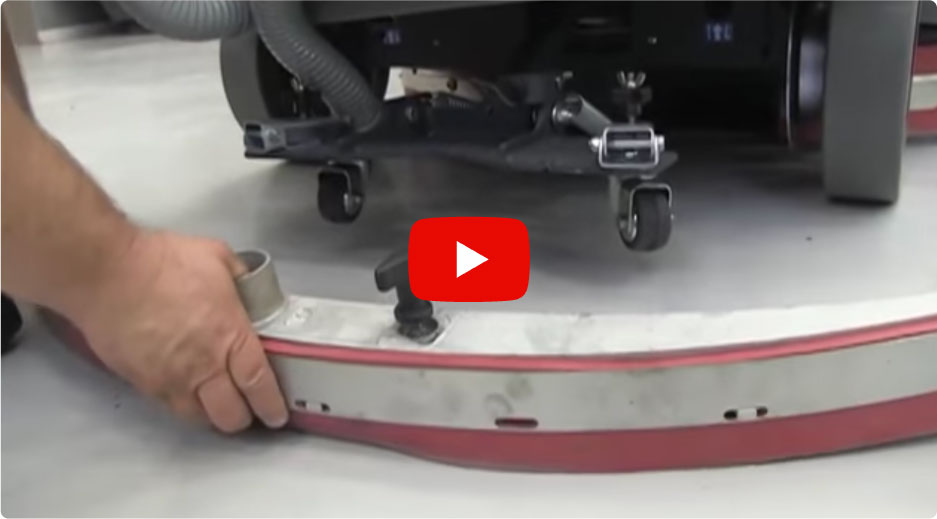Squeegees: Where the Rubber Meets the Road!

Does this situation sound familiar? You’ve invested in a scrubber or sweeper/scrubber to upgrade floor cleaning in your facility. You’re using brushes and a cleaning solution that are tailored to your unique requirements. But the machine is not drying the floor! What’s wrong??!!
The problem you’re seeing could be with the squeegee blades. While brushes and cleaning solutions loosen soil, it’s the vacuum/squeegee assembly at the back of the scrubber that removes the dirt and liquids, leaving the clean, dry floors you want. To determine the problem, inspect these four things:
- Vacuum motor – do I have good suction?
- Clogged or cracked vacuum hoses – is there a problem here?
- Proper settings on the squeegee tool – do I need to adjust the pitch? Hint: you want to see the rear blade bend the same from tip to tip, all along the length of the blade.
- Damage free, properly fitted squeegee blades – is it time to flip or replace?
Watch this detailed video, Maintaining Squeegee Systems, from Nilfisk Advance:
Problems with the worn squeegee blades or using the wrong type of squeegee blades can lead to less than satisfactory cleaning performance because you’re not able to get a good vacuum seal with the floor. When you have a good vac motor, good, clog-free hoses and properly installed, correctly adjusted, damage-free squeegees, your scrubber will leave you with clean, dry floors. You will also avoid premature and/or uneven wear of your squeegee blades.
In this article we discuss the basics of common squeegee materials as well as how to maintain the blades for the best results. We are also available and happy to recommend the best squeegees for your type of floors as well as troubleshoot problems that come up and when it is time to replace blades.
Squeegee selection
Front and rear squeegee blades and are made of several materials that are suited to different cleaning needs. Here are the basic types.
Gum Rubber (White / Tan)
- High grade gum rubber with additives to increase durability and tensile strength
- Average resistance to chemicals and abrasion
- Won’t stand up to harsh cleaning chemicals
- Good for general cleaning of fine floors like marble for instance
- NOT for oily and greasy cleaning applications
Durashield / Linatex (Red)
- Specially formulated premium squeegee material with superior flexibility
- Excellent abrasion resistance on rough floors
- Highly resistant to harsh cleaning chemicals
- Versatile - excellent results in a variety of applications
- NOT for oily and greasy cleaning applications
Neoprene (Black)
- Abrasion resistant
- Good for oily and greasy cleaning applications
- Could leave black marks on high gloss floors
Urethane (Natural as well as other colors)
- Premium material
- Improved performance over Neoprene
- Good for oily and greasy cleaning applications
- Stands up to harsh chemicals
- Durable
Here’s a great explanation of Gum, Linatex and Urethane (their Primothane) blades from our friends at FactoryCat!
Squeegee Blade Care
Worn or dirty squeegee blades will cause streaking and poor solution removal. Here are some recommended steps you can take to get the best from your squeegee blades:
- Make sure the edges of the rear blade are clean and square. Have operators inspect the blade and clean it with a damp soft cloth after each use.
- Check the front and rear squeegee blade for tears, gouges, and worn edges if you’re seeing streaky floors.
- Check the positioning of the squeegee tool. The blade edge should lightly touch the floor with about a 45º deflection.
- Have extra front and rear squeegee blades on hand for quick replacement. Under normal conditions a blade will last from 2 to 6 months, depending on frequency of use and type of floor.
There are actually four edges on each squeegee blade. When an edge becomes rounded, cut or torn, the blade can be reversed either top-to-bottom or right-to-left as long as there is an undamaged edge. This applies especially to the rear blade where you want sharp, clean, square edges. Only when there are no undamaged edges do you need to replace the blade.
When you replace or reverse a squeegee blade, adjust the squeegee tool pitch according to the manufacturer’s instructions so there’s a consistent seal with the floor along the squeegee’s length when the assembly is lowered.
Rely on Morrison
The squeegee is the last part of your scrubber to contact a floor—last but certainly not least. This seemingly simple component is where the rubber meets the road when it comes to cleaning. Make sure you’re using the right material and adjusting the blade for the best performance.
The parts professionals at your local Morrison Industrial branch are happy to help you find the best squeegees for your facility at the right price. We stock OEM quality, drop-in replacement parts, brushes, brooms and squeegees for all brands of industrial floor cleaning equipment—most available with one-day delivery—backed by our Customer Satisfaction Guarantee.
Our factory-trained service technicians offer ongoing support and fast, knowledgeable service for your floor cleaning equipment as well as your forklifts.
©




